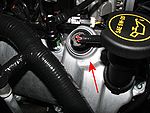
Variable Cam Timing
Encyclopedia

Automobile
An automobile, autocar, motor car or car is a wheeled motor vehicle used for transporting passengers, which also carries its own engine or motor...
variable valve timing
Variable valve timing
In internal combustion engines, variable valve timing , also known as Variable valve actuation , is a generalized term used to describe any mechanism or method that can alter the shape or timing of a valve lift event within an internal combustion engine...
technology developed by Ford
Ford Motor Company
Ford Motor Company is an American multinational automaker based in Dearborn, Michigan, a suburb of Detroit. The automaker was founded by Henry Ford and incorporated on June 16, 1903. In addition to the Ford and Lincoln brands, Ford also owns a small stake in Mazda in Japan and Aston Martin in the UK...
. It uses electronically controlled hydraulic valves that direct high pressure engine oil into the camshaft phaser cavity. These oil control solenoids are bolted into the cylinder heads towards the front of the engine near the camshaft phasers. The powertrain control module (PCM) transmits a signal to the solenoids to move a valve spool that regulates the flow of oil to the phaser cavity. The phaser cavity changes the valve timing by rotating the camshaft slightly from its initial orientation, which results in the camshaft timing being advanced or retarded. The PCM adjusts the camshaft timing depending on factors such as engine load and RPM. This allows for more optimum engine performance, reduced emissions, and increased fuel efficiency compared to engines with fixed camshafts.
For twin cam or DOHC engines, VCT was used on either the intake or exhaust camshaft. (Engines that have VCT on both camshafts are now designated as Ti-VCT.) The use of variable camshaft timing on the exhaust camshaft is for improved emissions, and vehicles with VCT on the exhaust camshaft do not require exhaust gas recirculation
Exhaust gas recirculation
In internal combustion engines, exhaust gas recirculation is a nitrogen oxide emissions reduction technique used in petrol/gasoline and diesel engines. EGR works by recirculating a portion of an engine's exhaust gas back to the engine cylinders. In a gasoline engine, this inert exhaust...
(EGR) as retarding the exhaust cam timing achieves the same result. VCT on the intake camshaft is used primarily for increasing engine power and torque as the PCM is able to optimize the opening of the intake valves to match the engine conditions.
VCT is used in Ford's Triton 5.4L 3-valve V8 engine, the Australian Barra
Ford Barra engine
The Barra engines are a family of straight 6s and V8s assembled by Ford Australia since 2002. The V8s are built in Windsor, Ontario by the Ford Motor Company and are shipped un-assembled to Australia. Production of the straight 6 is scheduled to continue until at least 2013...
182 and 240 Inline-6s, and Ford's 4.6L 3-valve V8 engine used in the 2006-2010 Ford Explorer
Ford Explorer
The Ford Explorer is a sport-utility vehicle sold in North America and built by the Ford Motor Company since 1990, as a replacement for the smaller but related Ford Bronco II. It is manufactured in Chicago, Illinois...
and 2005-2010 Ford Mustang GT.
The 2.0L Zetec Inline-4 used in the 1998-2003 Ford Escort ZX2, Ford Contour, and 99-02 Mercury Cougar used VCT on the exhaust camshaft. The 2002-2004 SVT Focus (ST170 in Europe) also featured VCT, but on the intake camshaft of its modified version of the 2.0L Zetec engine. In addition, the 1.7L Zetec-S engine found in the European Ford Puma
Ford Puma
The Ford Puma was a small sports coupé produced by the Ford Motor Company from 1997 to 2001 http://www.parkers.co.uk/cars/owners-reviews/search.aspx?range=438#fuel=P&Body=Coupe&transmission=M, for sale in Europe...
was equipped with variable camshaft timing. The 6.2L V8 introduced in the 2010 SVT Raptor also uses VCT. That motor has a single cam per bank, so it is dual-equal variable cam timing.
Ti-VCT
Twin Independent Variable Camshaft Timing (Ti-VCT) is the name given by Ford to engines with the ability to vary the camshaft timing of both the intake and exhaust camshafts independently. Despite the name difference, its operation is the same as standard VCT. Unlike the original versions of VCT, which only operated on a single camshaft, Ti-VCT allows the PCM to advance or retard the timing of both the intake and exhaust camshafts independently. This allows for improved power and torque, particularly at lower engine RPM, as well as improved fuel economy and reduced emissions.Many new Ford engines feature Ti-VCT, including the 2011 Mustang, 2011 Edge and Edge Sport, 2011 Lincoln MKX, 2011 Fiesta, 2011 Explorer, and 2012 Focus.

